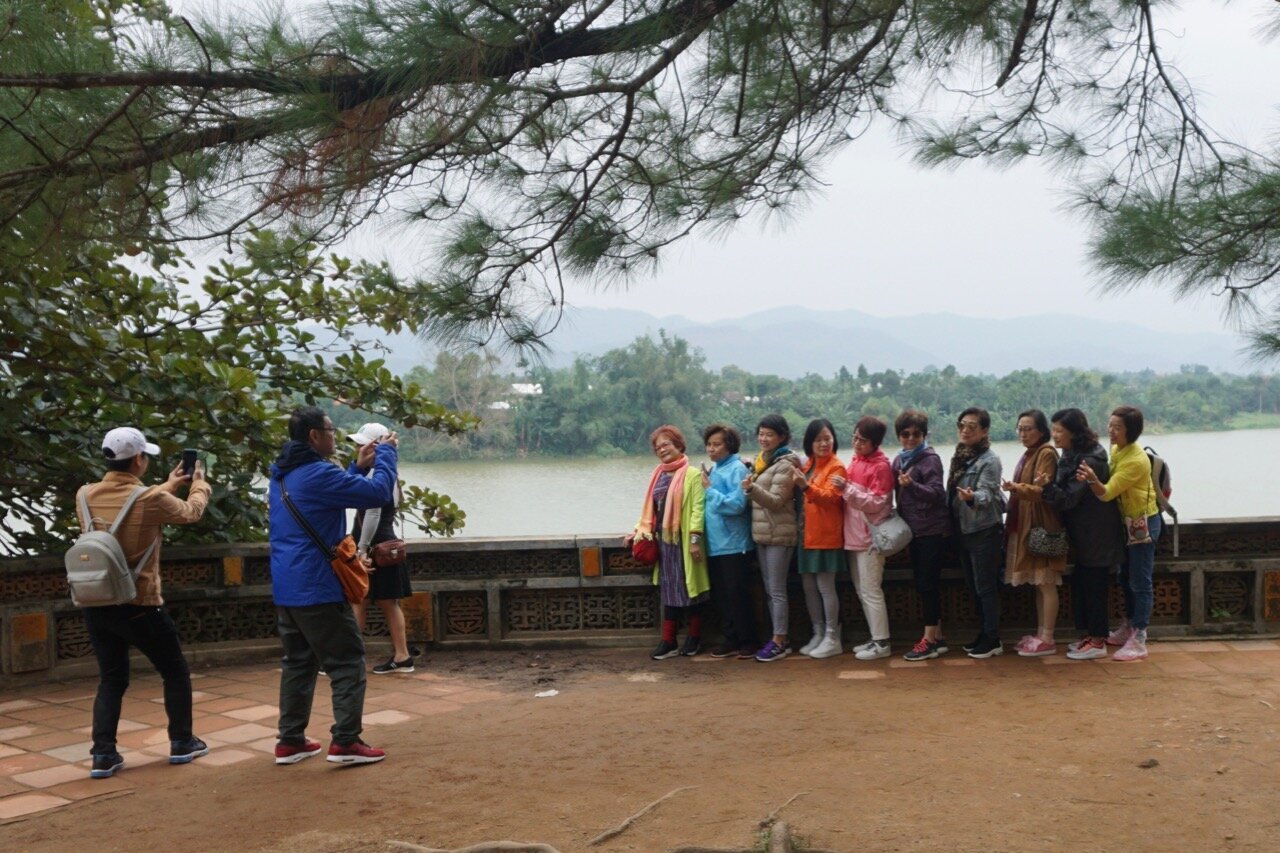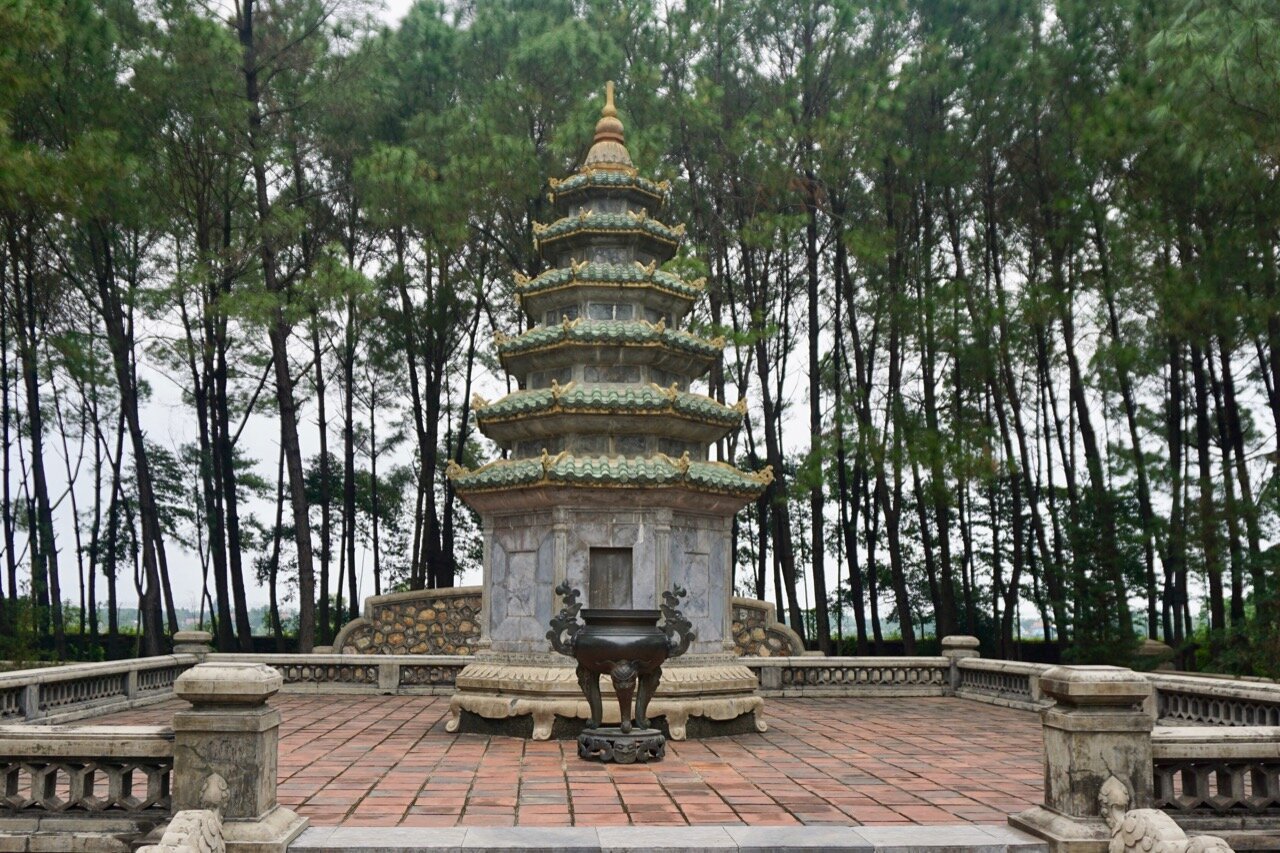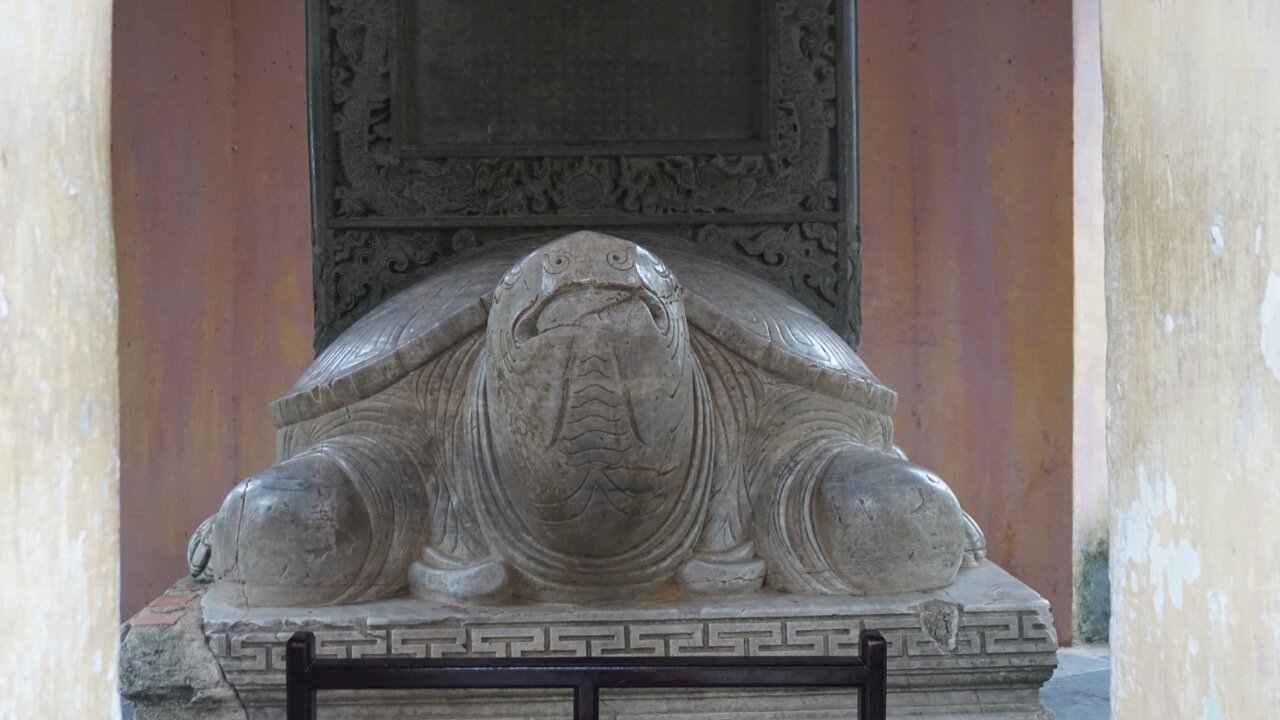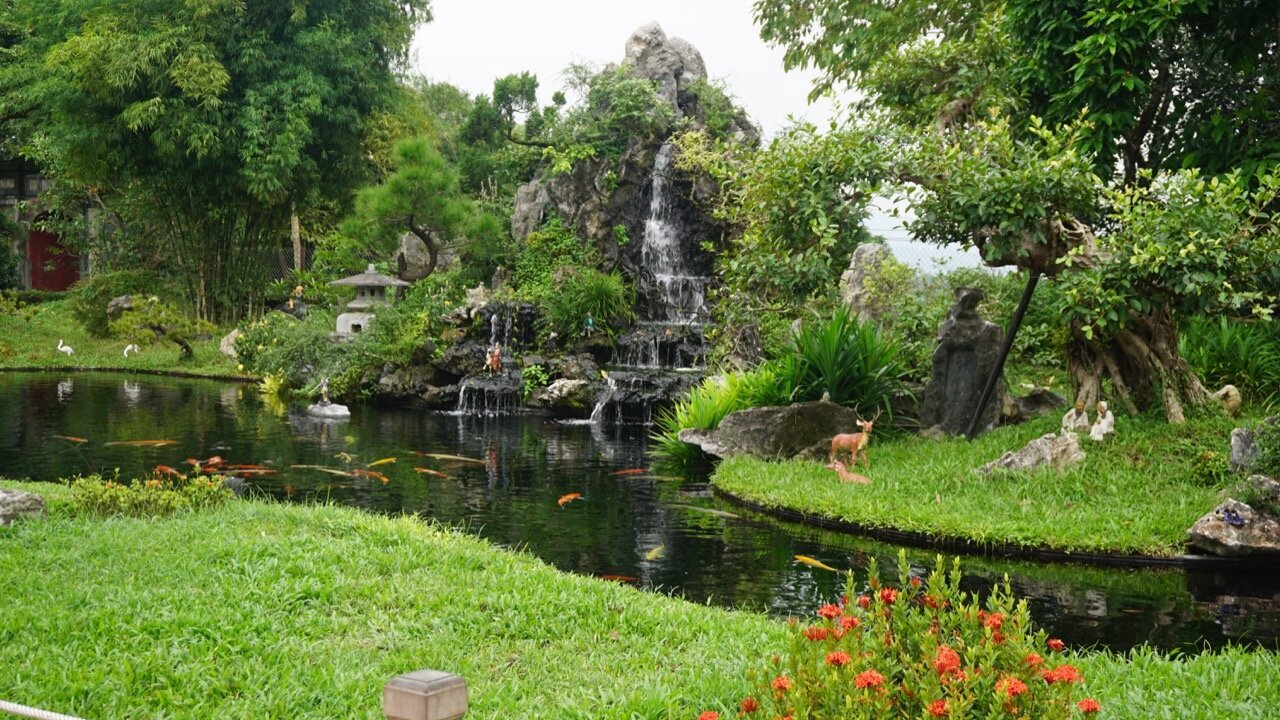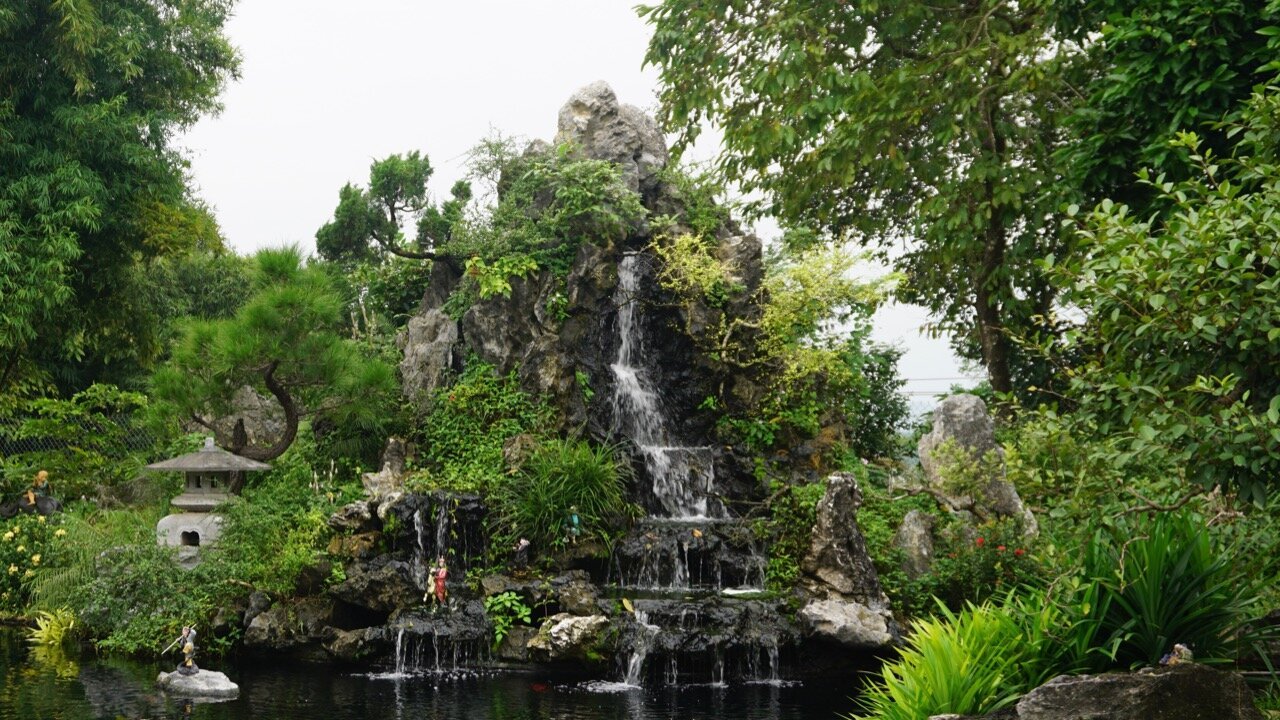Hue
From Hoi An we took a car over the mountain pass to Hue. The road hugged the mountains high above the coastline. Mist and rain obscured what were clearly many spectacular views, but we had our share.
Imperfections in a trip’s plan make themselves known as you live it out. One day—really, one afternoon—in Hue was not enough to do justice to this calm city of many tombs and famously good food. We did make an effort to see what we could: a funny young trainee at our hotel, My (pronounced Me), gave us an ideal afternoon’s varied itinerary: the Imperial City, her favorite tomb (!) (the Khai Dinh), and the Thien Mu pagoda.
We walked along the Perfume River to the Imperial City, the vast power complex from which the Nguyen dynasty ruled from 1804 to 1885, when the French took over. After that, the Imperial City and its emperors were largely symbolic—think Buckingham Palace and its denizens—until 1945 when the Nguyen dynasty ended. Abandoned to the weather and termites, the complex deliquesced, only to be further damaged by battles, first with the French, and then during the Tet offensive, when North and South Vietnamese occupied different parts of the city. Americans at first refrained from targeting the city due to its religious and cultural significance, but in the fierceness of the fighting, this rectitude soon dissolved.
Some modest portion of the Imperial City has been rebuilt and is now UNESCO protected. A maze of gardens and palaces, pavilions and hidden courtyards, temples and long galleries, the grounds go on and on. Making sense of the history was not easy; even posters describing the emperors were not in chronological order.
One of the reasons Michelle isn’t fond of many historical sites is that they are often wiped clean of the human element. But here, in the queen mother’s private residence, we found a five minute video which profiled one of her maids. The woman, now extremely old, was shown walking through her old haunts, and telling of how she was taken out of school at age eight to become a palace maid—and never played again. She was instructed at length in behavior, speech, and the endless ceremonies. She learned to dress the queen mother, and do her hair. Any mistakes were punished, she said, by flogging. Flogging! Her affect was flat; there was no wistfulness; her old face spoke more than the subtitles.
Thousands of people built the Imperial City; now thousands visit its most private corners.
Leaving, we stopped in for Vietnamese iced coffees—we have never had so much sugared caffeine in our lives, and have to admit, it’s an effective refueler. Going into the coffeehouse, a taxi driver solicited us. “No,” we said. “We’re getting coffee.”
“Maybe after,” he said.
And indeed, there he was. And he took us the 25 k to Khai Dinh tomb. And, he promised, to a good Banh Mi place.
At the tomb, he pointed to the food stall by the taxi stand where three women promptly fluttered around us. Our restaurant radar was ringing RUN, but being pushovers, we duly ordered one banh mi to share. Two young male backpackers from Israel were also being fluttered. They were appalled, as were we, by the banh mi itself-—this one set a very low bar for the national sandwich: a hot dog extruded from a pink plastic sleeve, an egg, a lot of mayo. Michelle resisted, but Jim was too polite to toss it in front of the women, who were now trying to get the Israeli guys to try nem chua, a cunning little leaf-covered block of fermented raw pork. One whiff and the men recoiled, which made the women shriek with laughter. “Not that we even keep kosher,” said one of the guys.
The tomb: We’d read about Emperor Khai Dinh on a poster in the Imperial City.He came to power in 1916; a weak, profligate man and a total French puppet, he was despised by his people. Like his ancestors, he wanted a great tomb and began to build it in 1925. The style is a hodgepodge of Hindu, Buddhist, Romanesque, and Gothic flourishes. The result—at least the situation and exterior, are thrilling: a series of steep stone steps with humorously carved bulging-eyed stone dragons for handrails takes you up and up to the mausoleum.Near the top, 12 stone guardians stand mutely, with stone horses and elephants. All of it, though not ancient, has the dark and moldering look of very old stone—the Hue weather ages things artfully.
In the mausoleum itself, there is some fancy-dancy mosaic tile work, gilt, and boiserie reflecting Khai Dinh’s obvious Francophilia and lavish taste.
Ferried away by our trusty taxi driver—Viet, 36, a father of two—our next stop was the Thien Mu Pagoda, back in town on a hill above the Perfume River.
Here, the first temple was built in 1601, although the eye-catching landmark seven-story pagoda wasn’t erected until the early 20thCentury by the construction-happy Nguyens. There is also an enormous stone turtle with a stelae on its back, and a big old bell that, when rung, can supposedly be heard for 10 kilometers. (Take that, U2, you with your 72 foot speakers at the Rose Bowl).
Garaged on the temple grounds is the blue Austin that carried the Buddhist monk Thich Quan Duc to his self-immolation in Saigon in 1963. The photograph of his immolation—as mind-blowing and heart-wrenching today as it was 46 years ago—created worldwide attention to the harsh mistreatment of Buddhists in Vietnam.
By evening, we’d had little to eat—except for the regrettable banh mi. (That sweet coffee can keep you up and running, though.) The helpful trainee My had suggested a well-known, high end French restaurant, but after sleuthing about on the internet, we demurred in favor of Hanh Restaurant. As the night was cold and rainy, Jim, who had a scratchy throat, was not happy to see that the modest-looking restaurant was open-air. He ordered a hot ginger tea, and Michelle asked for lemon juice (often a sweet, cold limeade)—and both items came enhanced, Michelle’s juice with slivers of licorice root and a dried plum (that added a lovely trace of salt); Jim’s tea with lemon, honey and fresh ginger. As with Michelle’s home remedy potion in Hoi An, Jim’s hot drink promptly cured him.
For people just like us—rank newcomers in town—Hanh offers a menu of the area’s greatest hits for 110,000 dong (about $5). And guess what our very first course happened to be? Yes…nem lui! In this case, the minced fermented pork had been formed into small paddles on lemongrass skewers, then well-barbecued. To eat these skewers, you wrap the meat part in rice paper with lettuce and herbs, pull out the lemongrass stalk, and dunk the roll in the house peanut sauce! Juicy, garlicky, crackly, fresh, and meaty.
We also had tiny dishes of banh beo, individual steamed rice cakes topped with minced shrimp and peanuts that you douse with a sweetened fish sauce, loosen with a spoon, and slurp like an oyster. (How did we know to do all this wrapping and dousing? The wait staff, kind and high-humored, swooped in to explain each dish and how to eat it.)
When Michelle was a banquet waitress at a country club, a food and beverage supervisor was hired to improve the restaurant—and it’s unruly, anarchic wait staff; he told the waiters that they were in charge of a person’s dining experience; the food might be good or bad (waiters had little control over that) but they could make people feel heard, attended to, and pampered.
It’s rare to have servers who take seriously the responsibility of creating a memorable experience for their customers, but the good-natured, funny waiters at Hanh did just that. In that chilly open space, with kids running through, and a dog barking in the back, we had a marvelous time eating a yellow rice crepe stuffed with bean sprouts and shrimp (banh koai); some sauced BBQ pork in a soft, blanket-like rice noodle (banh cuon thit nuoi). We’d left small fried spring rolls (nem ran) for last, but the cunning little packets had stayed piping hot. Black sticky rice (juicy and sweet as berries) in coconut yogurt is now Michelle’s new favorite dessert.
Back at the hotel, the concierge said that Hahn was very popular and always full, but the cold weather must have kept the crowds away—we’d been lucky to get in.
In the morning, our trusty taxi driver was there precisely at 8:15 to take us to the airport. It was way too soon to bid goodbye to Hue.
